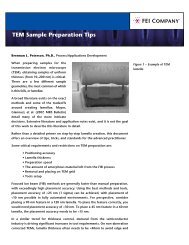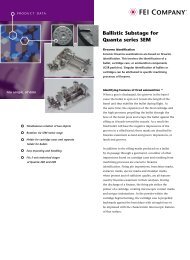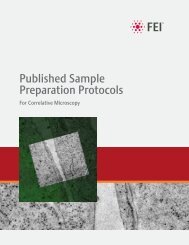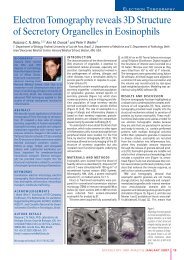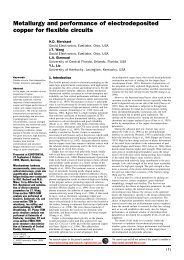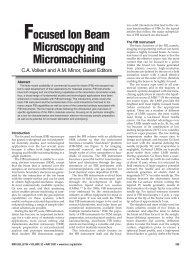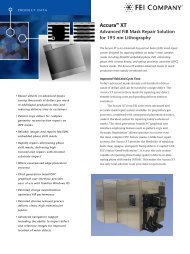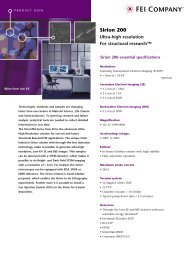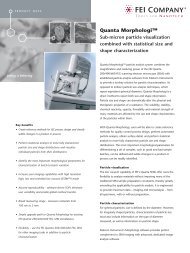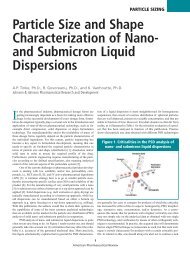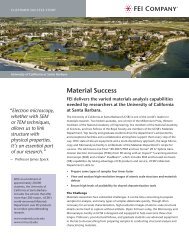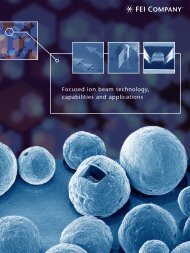Wet STEM: A newdevelopment in environmental SEM for imaging ...
Wet STEM: A newdevelopment in environmental SEM for imaging ...
Wet STEM: A newdevelopment in environmental SEM for imaging ...
You also want an ePaper? Increase the reach of your titles
YUMPU automatically turns print PDFs into web optimized ePapers that Google loves.
part of the <strong>in</strong>terest of wet <strong>STEM</strong>. The specimens<br />
can <strong>in</strong>deed be ma<strong>in</strong>ta<strong>in</strong>ed <strong>in</strong> their wet state, so that<br />
particles <strong>in</strong>cluded <strong>in</strong> a layer of liquid are imaged.<br />
In this way, they are neither de<strong>for</strong>med nor<br />
collapsed, and their size can be correctly estimated.<br />
If required, their dynamic evolution can also be<br />
followed <strong>in</strong> situ, when evaporation occurs <strong>for</strong><br />
example. Secondly, the quite lowvoltages used <strong>in</strong><br />
<strong>SEM</strong> (1–30 kV) <strong>in</strong> comparison with TEM give<br />
access to a higher number of electrons–sample<br />
<strong>in</strong>teractions, result<strong>in</strong>g <strong>in</strong> more contrasted images<br />
[11]. F<strong>in</strong>ally, thanks to the development of field<br />
emission guns [12], the resolution available <strong>in</strong> <strong>SEM</strong><br />
is nowappreciable, so that <strong>SEM</strong> imag<strong>in</strong>g becomes<br />
an easy characterization method with a very high<br />
resolution, reach<strong>in</strong>g 1 nm <strong>in</strong> <strong>STEM</strong> mode at an<br />
acceleration voltage of 20 kV. Thanks to the field<br />
emission gun, nano-particles or objects around<br />
20 nm can easily be imaged <strong>in</strong> wet <strong>STEM</strong> mode,<br />
where the resolution has experimentally been<br />
shown to be lower than 5 nm (colloidal solution<br />
of Au particles).<br />
Another <strong>in</strong>terest of the wet <strong>STEM</strong> mode <strong>in</strong><br />
E<strong>SEM</strong> is the fact that it br<strong>in</strong>gs a newpallet of<br />
imag<strong>in</strong>g possibilities. Indeed, <strong>in</strong> the case of nanoobjects<br />
<strong>in</strong>cluded <strong>in</strong> a liquid, classical E<strong>SEM</strong><br />
imag<strong>in</strong>g shows some limits. A characteristic of<br />
wet <strong>STEM</strong> imag<strong>in</strong>g method vs. classical E<strong>SEM</strong>,<br />
thanks to transmission mode, is the access to<br />
volume <strong>in</strong><strong>for</strong>mation <strong>in</strong> a liquid. As we image the<br />
entire volume of the liquid, we observe not only<br />
the smooth surface of the colloidal solution or<br />
some particles emerg<strong>in</strong>g from this liquid phase,<br />
but also objects deep <strong>in</strong>side a liquid layer, and<br />
the way particles are piled up, whilst be<strong>in</strong>g limited<br />
by electrons transmission. Areas of particles<br />
layers superposition can also be detected and<br />
imaged.<br />
Images <strong>in</strong>terpretation sometimes leads to questions,<br />
and it is still difficult to expla<strong>in</strong> every<br />
contrasts theoretically because of the complexity<br />
of the numerous diffusion mechanisms <strong>in</strong>volved <strong>in</strong><br />
images <strong>for</strong>mation. This aspect still needs further<br />
<strong>in</strong>vestigation, through the development of Monte<br />
Carlo simulation. However, it is already possible<br />
to state some remarks about the colloidal solutions<br />
imaged. Particles imaged <strong>in</strong> this mode usually<br />
exhibit a halo or brighter contrast around the<br />
ARTICLE IN PRESS<br />
A. Bogner et al. / Ultramicroscopy 104 (2005) 290–301 299<br />
particle. In annular dark-field conditions, the<br />
contrast can be described as a mass–thickness<br />
<strong>in</strong>verse type [13]. As a result, brighter contrasts are<br />
<strong>in</strong>terpreted as thicker or higher atomic number<br />
composition areas. In this way, biggest particles<br />
look brighter, and light their environment so that a<br />
large area around big particles looks brighter, and<br />
the halo effect is enhanced <strong>for</strong> each particle. In<br />
addition, particles <strong>in</strong> colloidal state are often<br />
stabilized thanks to ionic surfactants. The presence<br />
of these negative charges may <strong>in</strong>teract with<br />
diffused electrons and participate to create a halo<br />
around particles.<br />
In a TEM, high collection angles are not used<br />
because the signal would suffer from lens aberrations.<br />
Other benefits occur <strong>in</strong> our case, thanks to<br />
<strong>SEM</strong> characteristics: high angles can be used <strong>for</strong><br />
collection result<strong>in</strong>g <strong>in</strong> an <strong>in</strong>creased signal level<br />
[12,14] and lowvoltages available <strong>in</strong>duce an<br />
improved contrast.<br />
<strong>Wet</strong> <strong>STEM</strong> requires th<strong>in</strong> samples <strong>in</strong> order to<br />
obta<strong>in</strong> an important transmission signal. In the<br />
case of colloidal solutions, this lowthickness<br />
elim<strong>in</strong>ates the usual drift phenomenon always<br />
occurr<strong>in</strong>g on large size drops, which prevents<br />
imag<strong>in</strong>g even with high scann<strong>in</strong>g rate acquisition.<br />
Liquid is <strong>in</strong>deed ma<strong>in</strong>ta<strong>in</strong>ed on small areas def<strong>in</strong>ed<br />
by the TEM grid, through copper squares and<br />
holes <strong>in</strong> the carbon layer. These small areas can be<br />
observed us<strong>in</strong>g slowscan imag<strong>in</strong>g conditions,<br />
known to <strong>in</strong>crease image quality especially <strong>in</strong><br />
<strong>environmental</strong> mode.<br />
Polymers or other organic objects are very high<br />
damage-sensitive samples, moreover, <strong>in</strong> the presence<br />
of water [15], and are not adapted to several<br />
imag<strong>in</strong>g of a given area. However, damage effects<br />
can be reduced by us<strong>in</strong>g low-dose methods [16].<br />
Focus, astigmatism and wobblers readjustments<br />
are done away from the image, the beam then<br />
be<strong>in</strong>g moved on the area of <strong>in</strong>terest just <strong>for</strong> the<br />
acquisition. The aim is to prevent beam damage on<br />
the area prior to the image record<strong>in</strong>g. This<br />
m<strong>in</strong>imizes the exposure time and the cumulated<br />
dose. In addition, as a compromise between<br />
contrast and damage, the maximum acceleration<br />
tension has been used (30 kV), because<br />
higher tension means lower electron–sample <strong>in</strong>teractions<br />
[11].



